Score breakdown
Things we like
- Bold but handsome looks
- Space and comfort
- AWD diesel powertrain
- Three-row boot space
Not so much
- Push button gear-selector
- Transmission busy in active cruise control
Three-row SUVs have replaced the station wagon as the ultimate family vehicle. However, some models that call themselves seven-seaters soon become redundant once the youngest offspring grow legs. Then there’s the issue of limited boot space when they’re being used as a bus.
Enter the Hyundai Palisade, the Korean’s car-maker’s biggest SUV to date, which brings everything good about the popular Hyundai Santa Fe but in a longer, roomier package that can seat up to eight people, including three down the back.
We jumped into the mid-priced Palisade Elite seven-seater with the 2.2-litre diesel all-wheel-drive powertrain to see if this American-centric SUV is worth the additional cost and parking space.
? You’re reading about an older model, here’s something newer
STORY CONTINUES
Pricing and ownership

The Palisade consists of three spec grades, the eponymous Palisade, Palisade Elite and Palisade Highlander, with each costing about $8000 more than their Santa Fe counterpart.
As with the Santa Fe, each Palisade variant comes with a choice of V6 petrol with front-wheel drive or a four-cylinder turbo-diesel with AWD. You also get the option of seven or eight seats, the seven-seaters coming with two fancy captain’s chairs in the middle row for the same price.
Retail pricing starts at $55,000 before on-road costs for the entry-level 3.8-litre V6 petrol Palisade, with the AWD diesel powertrain attracting a $4000 premium.
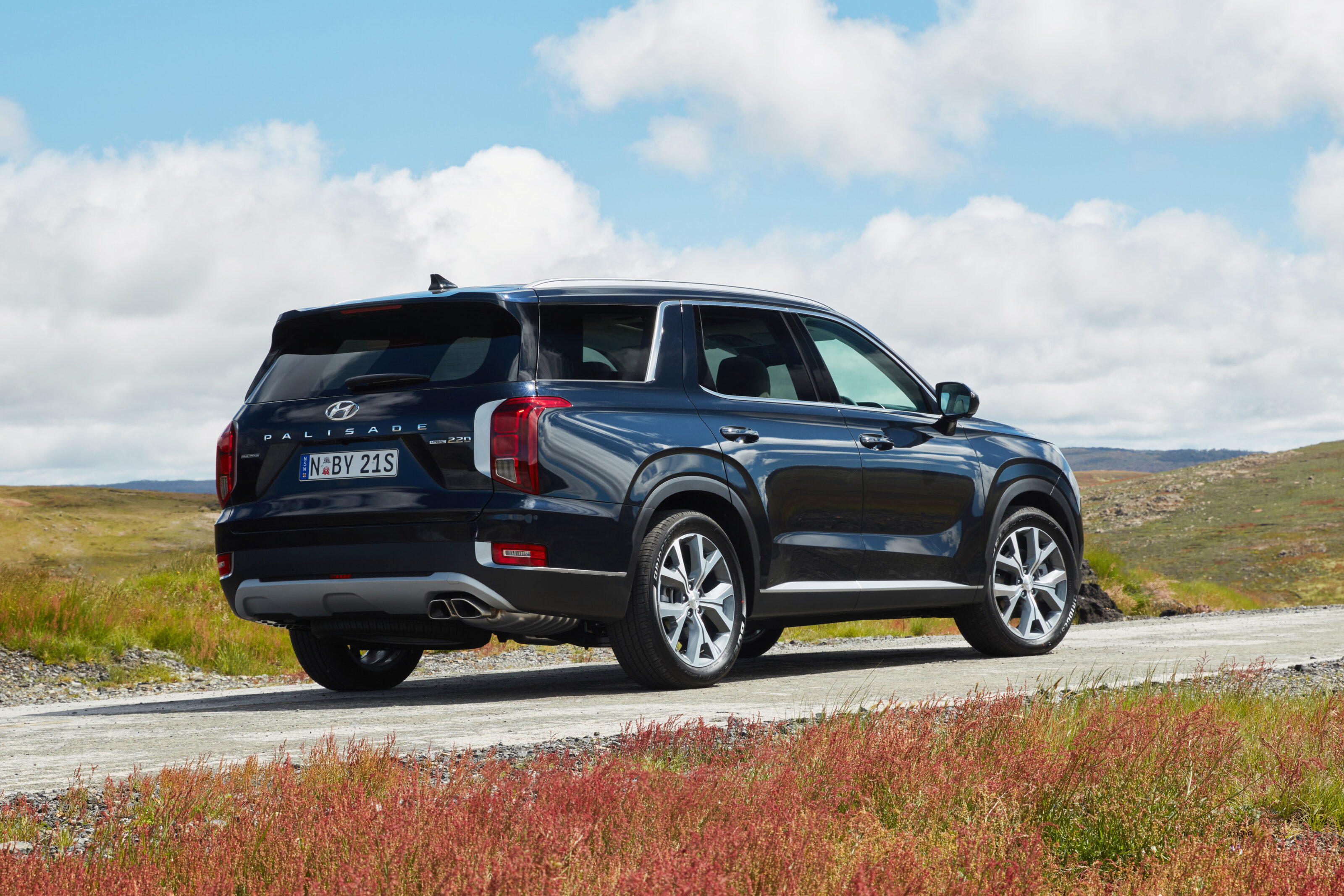
The Elite, which joined the local Palisade range in August 2021, starts at $61,500 for the V6 petrol, with the diesel priced from $65,500 before selecting options such as premium paint ($695) while the range-topping petrol and diesel Highlander variants are priced from $71,000 and $75,000 respectively, which means they attract the Luxury Car Tax (prices before on-road costs).
As far as our test vehicle’s running costs go, the 2.2-litre diesel engine has an official combined fuel economy of 7.3L/100km, which is quite good for a vehicle this size and considerably more frugal than the 3.8-litre V6 petrol’s 10.7L/100km thirst.
Service costs are also reasonable. After a free 1500km check, the Palisade is due for a service every 12 months or 15,000km, whichever comes first. Each scheduled visit to the Hyundai service centre will cost $469 for the first five years or 75,000km.
Hyundai also offers pre-paid servicing, with three, four, or five-year packages respectively priced at $1187, $1596, and $1995. This will save you $350 over five years.
The Palisade is covered by Hyundai Australia’s five-year/unlimited-kilometre warranty.
Features
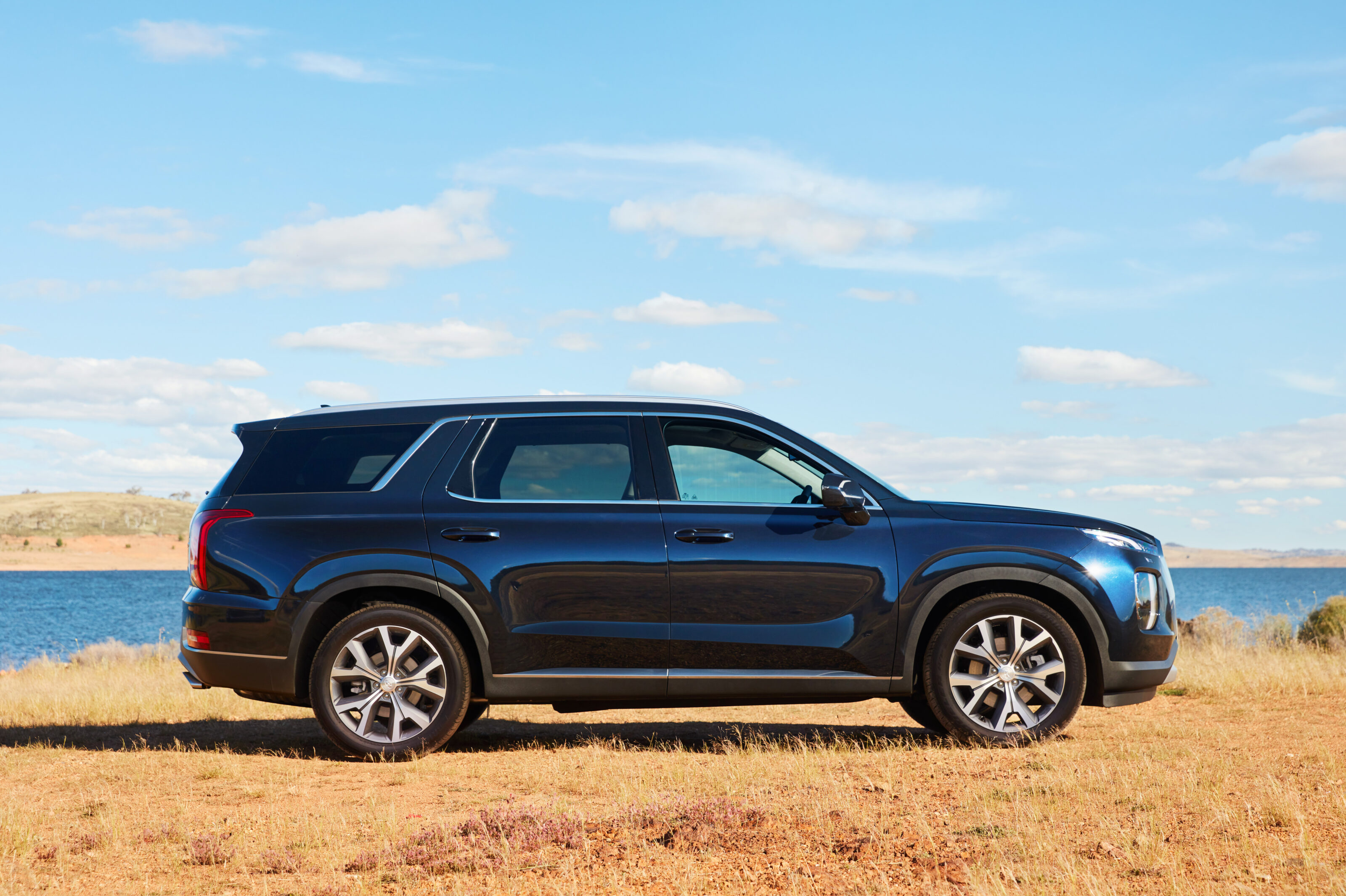
The rather handsome-looking Palisade Elite comes with a decent mid-spec standard features list, which includes black leather upholstery, a 10.25-inch infotainment screen, Apple CarPlay/Android Auto, satellite navigation, 12-speaker Infinity audio system, 7.0-inch digital gauge cluster, powered driver’s seat adjustment, heated front seats, three-zone air-conditioning, wireless charging pad, keyless entry, push-button start, power-operated tailgate, single-pane sunroof, dual-LED headlights, rear LED combination lamps, and 20-inch alloy wheels.
Like the rest of the range, it also comes with the Hyundai SmartSense active safety suite, which we’ll take a look at in the Safety section below.
If you fancy extra bling, opt for the Urban X pack that brings integrated side steps and gloss-black wheels. Or opt for the Urban X Plus pack that adds roof racks and tinted style visors
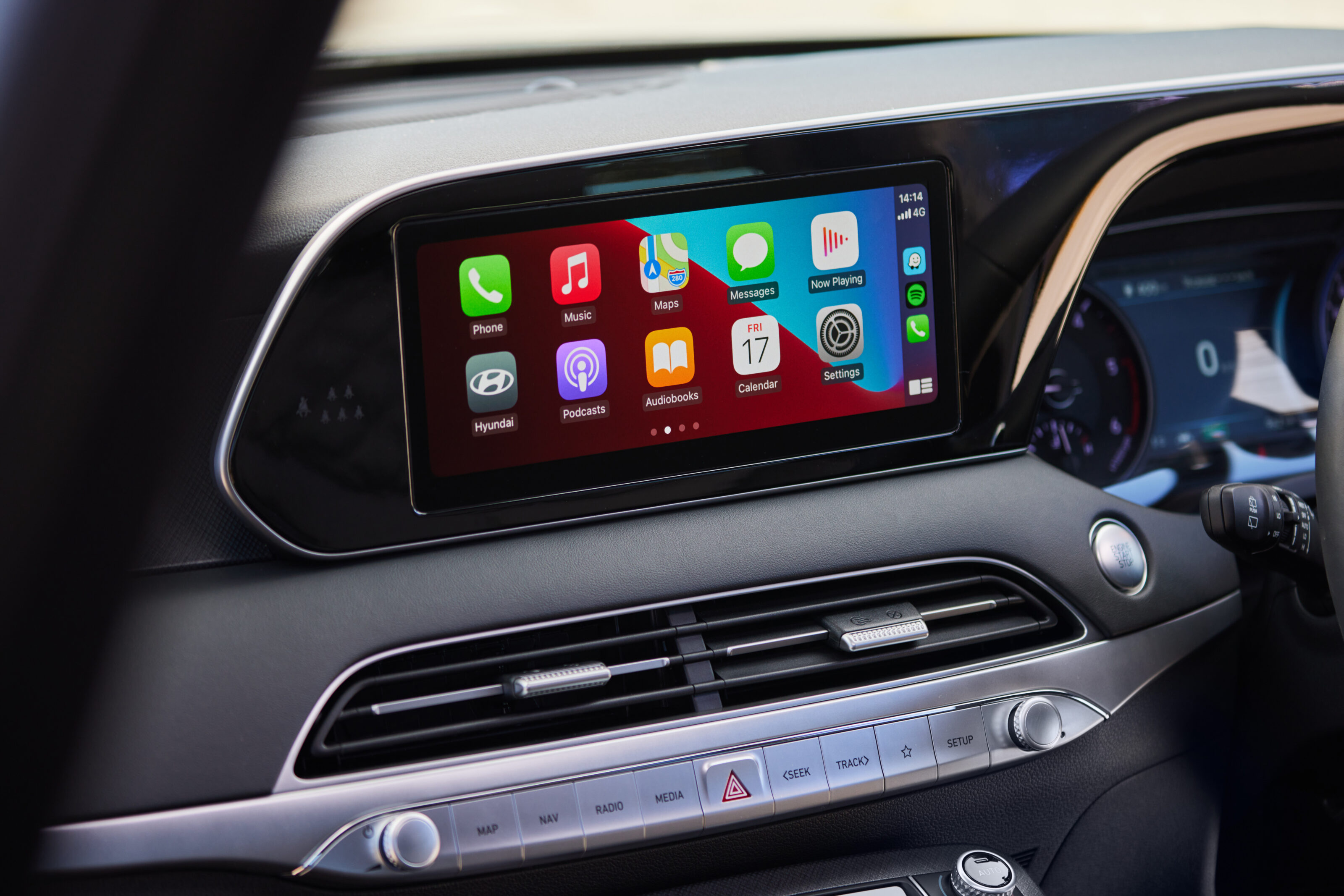
There are five external colours to choose from, including the standard White Cream that’s part of the price, or for an extra $695 you can choose from Abyss Black, Sierra Burgandy, Steel Graphite and Rain Forest.
If you fancy a little extra bling you can opt for the Urban X accessory pack that for $3562.22 brings integrated side steps and fancy gloss-black alloy wheels. Or, for $4043.96, you can opt for the Urban X Plus pack that adds flush roof racks and tinted style visors to the Urban X extras.
Space and Comfort
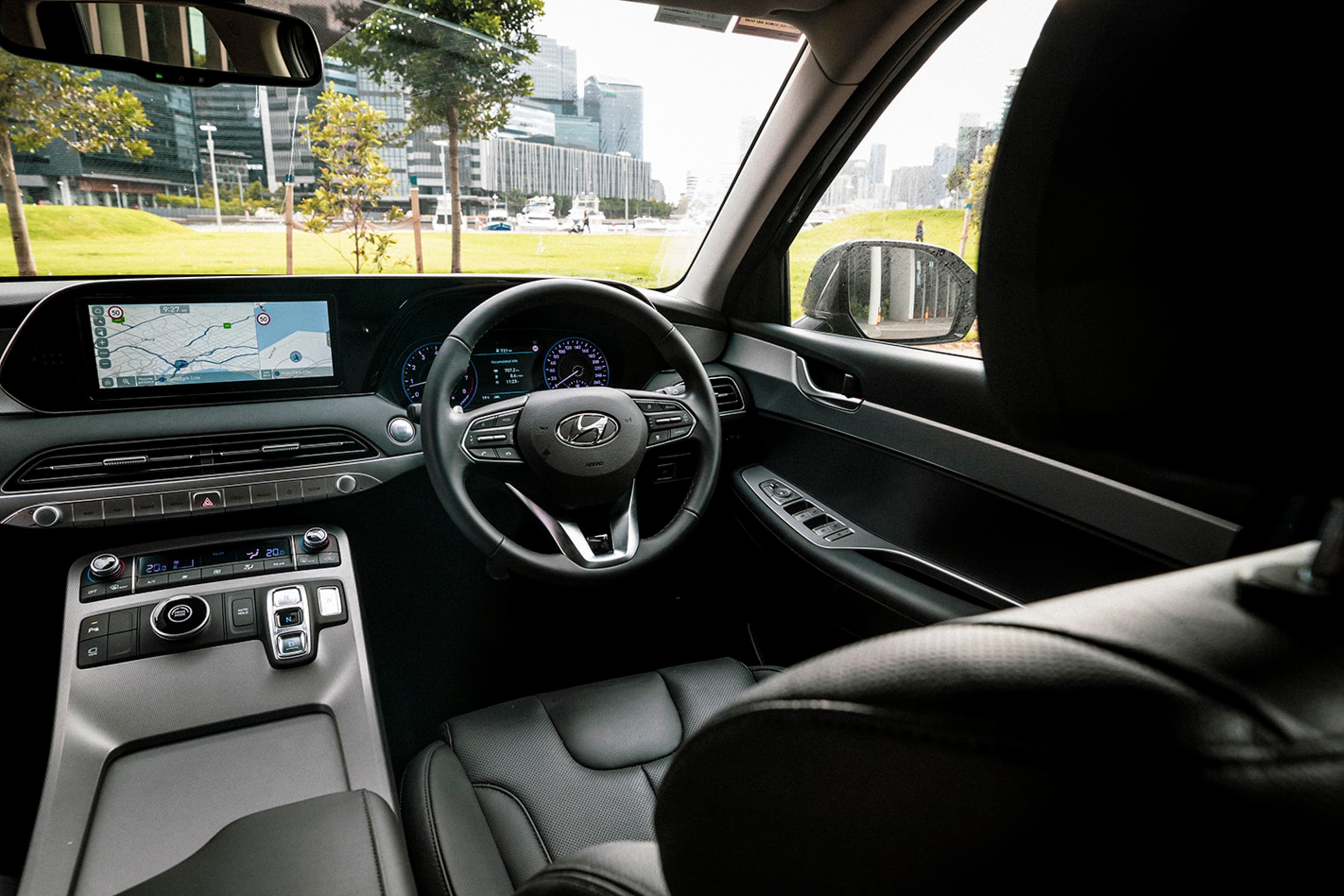
Needless to say, any SUV about the size of a Kia Carnival people mover won’t be lacking when it comes to space and comfort, even in the third row.
Stepping into the spacious cabin provides a great first impression. The fit and finish seem to be of a high standard with an elegant mix of soft touchpoints, stitched upholstery and contrasting metallic trim.
The heated leather front seats are comfortable, with the driver’s side benefiting from 10-way power adjustment including lumbar support.
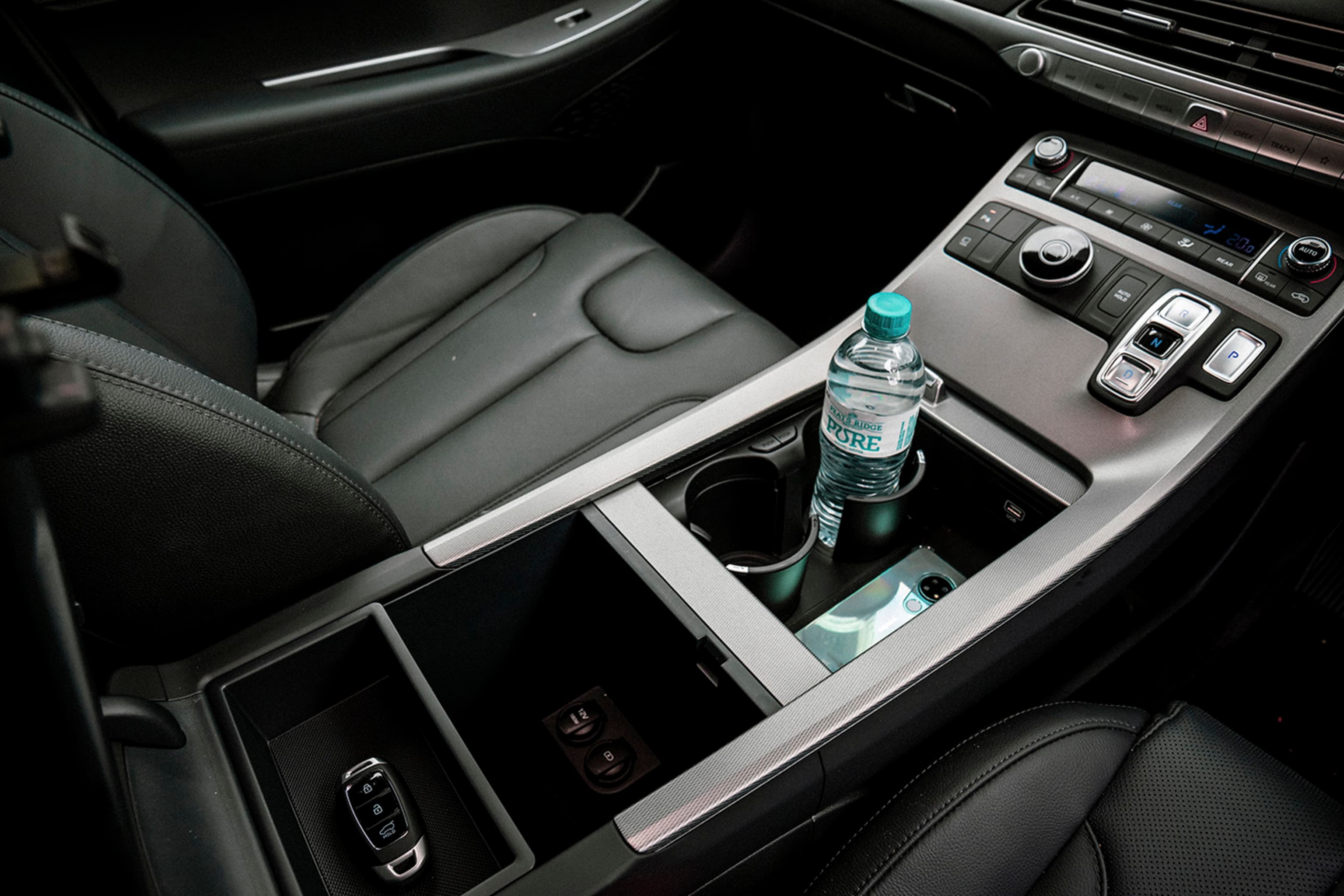
Plenty of elbow room is provided up front, where the occupants are separated by a broad double-deck centre console that provides plenty of storage space including a deep tub beneath the padded centre armrest and upper and lower storage trays. It also houses two cup holders, two USB charging ports, another USB socket to connect your phone to the infotainment system, and two 12-volt sockets. It’s also clutter-free thanks to the push-button gear shifter that takes up little space.
The second row is very spacious, especially in this seven-seat version that has just the two captain’s chairs instead of a three-seat bench. The airliner-like seats have fold-down centre armrests and there is a wide enough gap between them to access the third row.
Second-row passengers get their own climate control buttons, ceiling-mounted air vents, two USB ports, a 12-volt socket and cup holders in the door armrests.

The third row is one of the roomiest of any large SUV with great leg and headroom. But while the rear bench can seat three people, it can be quite a squeeze even for older children. Two adults will be comfortable here, even on longer journeys. The two USB ports, four cup holders and ceiling mounted air vents won’t make them feel like they’ve drawn the short straw, either.
I reckon it is best thinking of the seven-seat Palisade as a six-seater plus. If I really needed seven seats, for say five growing children, I’d choose the eight-seater to comfortably accommodate three in the middle and two at the rear. And if you only seat two people in the second row, the centre backrest folds down to create a handy table that you don’t get with the captain’s chairs.
The third row offers a more pleasant experience than most other seven-seaters, while the ‘driver talk intercom’ allows communication with those in the front for better inclusivity
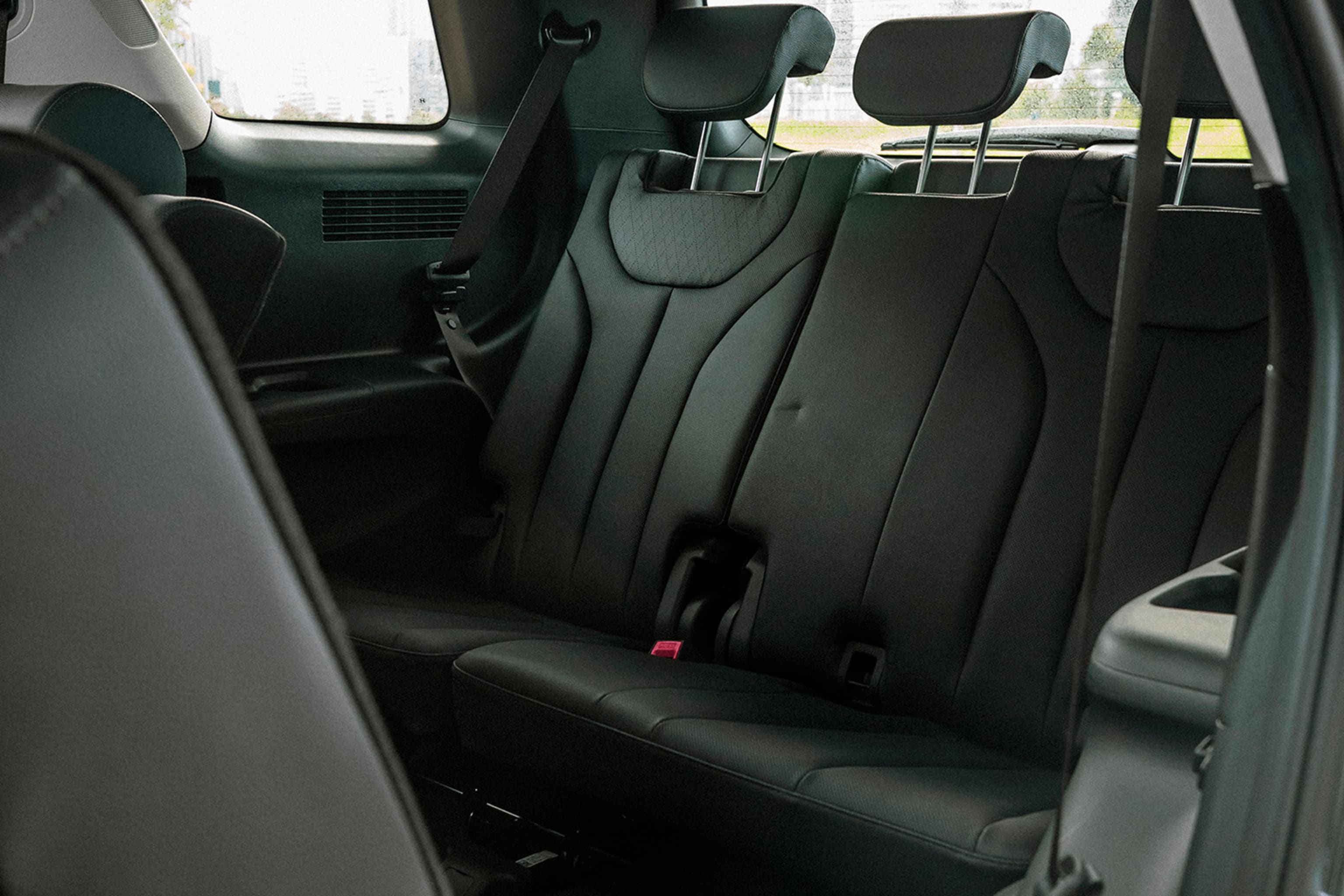
Whichever layout you choose, the third row offers a more pleasant experience than most other seven-seaters, with good forward and side vision, while the ‘driver talk intercom’ system allows communication with those in the front for better inclusivity.
Entering the third row is done by moving the passenger rear seat forward and folding the backrest down, which is all done with the push of a single button. This provides plenty of space to make entering and exiting a bit more of an elegant affair compared to most other seven-seaters.
Once seated, the third-row seatbacks recline up to 10 degrees and spilt 60:40 for versatile cargo-carrying capacity, which is another ace up the Palisade’s sleeve. While most seven-seaters have tight boot space behind the third row, the big Hyundai can carry a hatchback-like 311 litres. By comparison, the Santa Fe holds just 130-litres of stuff while its Kia Sorento cousin and the Mazda CX-9 hold 230 and 187 litres respectively.

With five seats in play, the Palisade holds a capacious 704 litres, which again is considerably more than the Santa Fe’s 547 litres. However, it is smaller than the CX-9 (810 litres) and Sorento (821 litres) due to its extra length mostly catering for more space from the third row and back.
Fold the middle row seats down and you’ll easily fit a single bed and then some.
Should you need to carry more, the Palisade has roof rails on which to install roof racks. Both the diesel and petrol variants come with a 2200kg braked towing capacity and up to 750kg unbraked.
On the Road
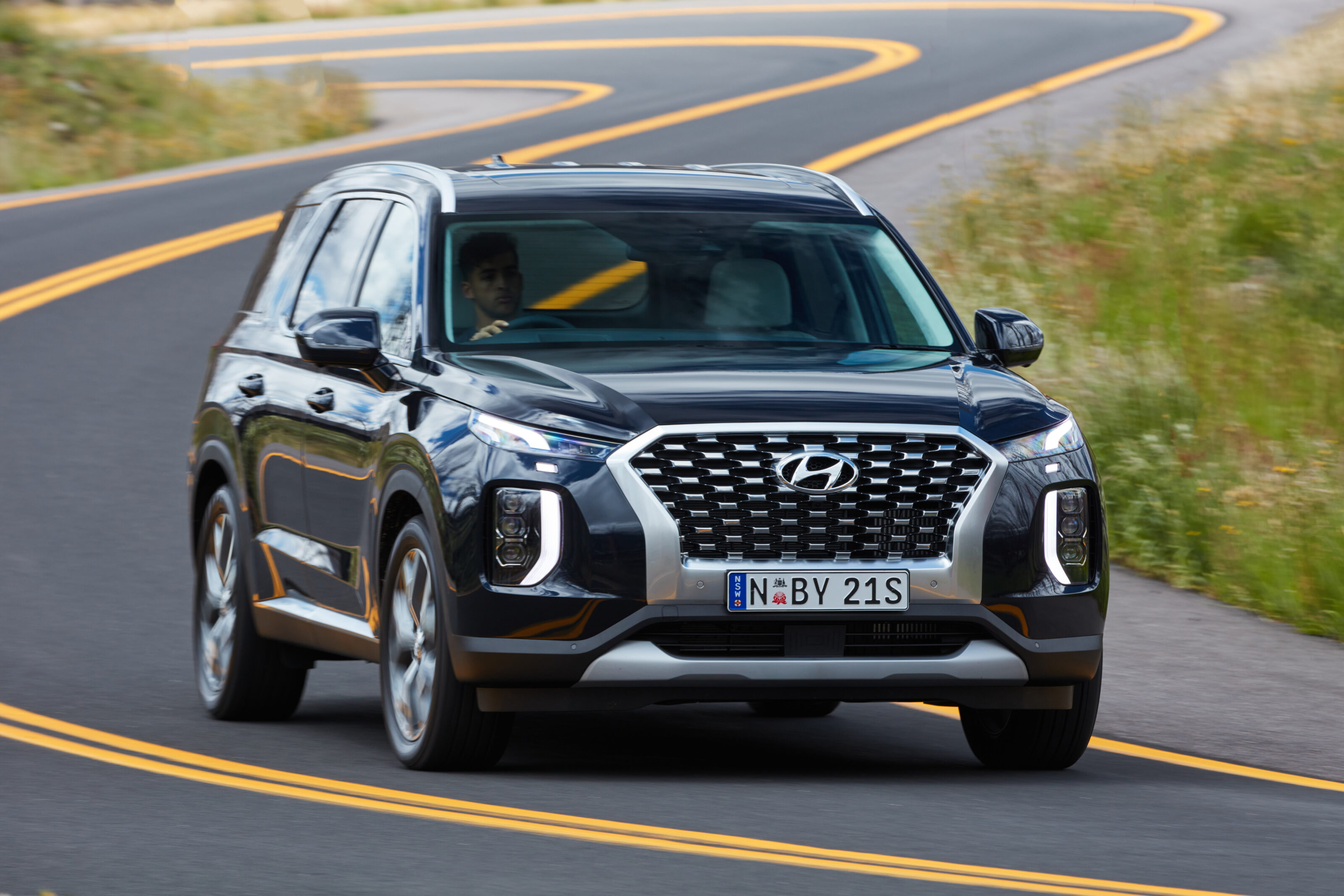
Buyers looking for an SUV this size often turn to ute-based models such as the Ford Everest, Mitsubishi Pajero Sport and Isuzu MU-X, which ride on ladder-frame chassis that make them feel rather agricultural compared to soft-roaders.
Which makes the Palisade rather unique in that it has all the space they offer and more, but with excellent road manners. This is a very comfortable SUV to drive and in which to be a passenger wherever you’re sitting, with multi-link rear suspension providing a firm and composed ride without being harsh, even on the Elite’s bigger 245/50 R20 tyres.
And while it lacks its 4X4 rivals’ genuine off-road capability, a handy 203mm of ground clearance and AWD traction allow the Palisade to tackle a range of unkempt roads, assisted by Snow, Mud and Sand driving modes that set the traction control and torque delivery to suit each surface accordingly.

Other drive modes, controlled on a dial next to the push-button gear selector, include Comfort, Sport and Eco, while Smart mode switches between the different modes based on driving style and conditions.
Handling wise, the Palisade feels quite nimble for an SUV that takes up about 10 square metres of real estate. The electric power steering feels light but direct and tightens up in Sport mode so there is less play at higher speeds. Selecting Comfort modes slackens it for slower speeds and parking.
At 1750mm high, you’d expect some body roll on sharper turns, but its huge footprint helps negate that so it always feels well planted to the road.
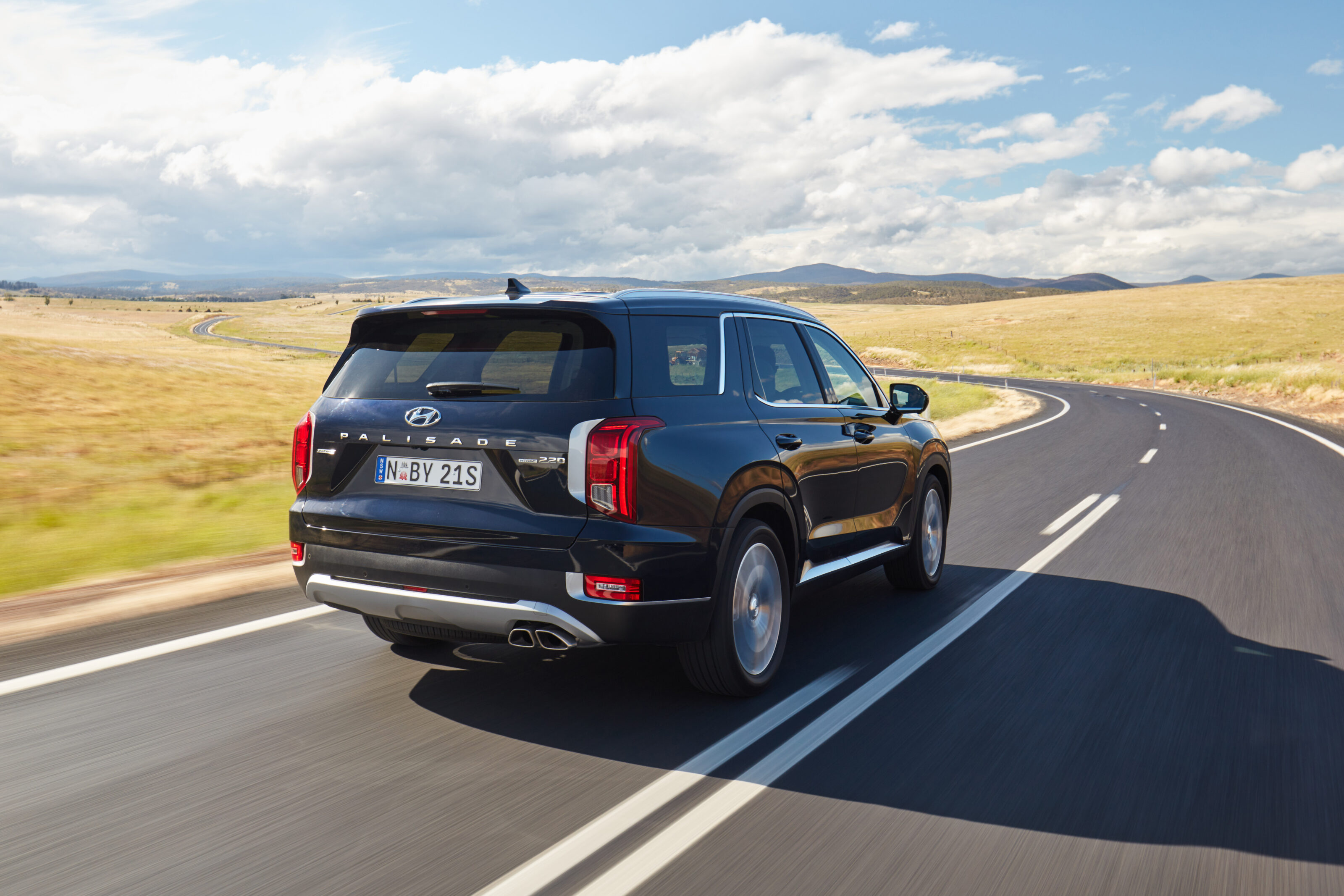
The Palisade’s refined ride is backed up by a notably hushed cabin even at highway speeds. You’d be forgiven for thinking you’re driving a petrol vehicle such is the lack of rattle from the 147kW/440Nm 2.2-litre four-cylinder turbo-diesel engine.
Coupled with an eight-speed automatic transmission, it feels lively from the get-go, with peak torque coming in at just 1750 rpm. Unlike the FWD V6 petrol, the diesel Palisade doesn’t suffer from a lack of traction at the front end, which can result in wheel chirping when you set off from the traffic lights without even trying.
This is a very comfortable SUV to drive and in which to be a passenger, with multi-link rear suspension providing a firm and composed ride without being harsh
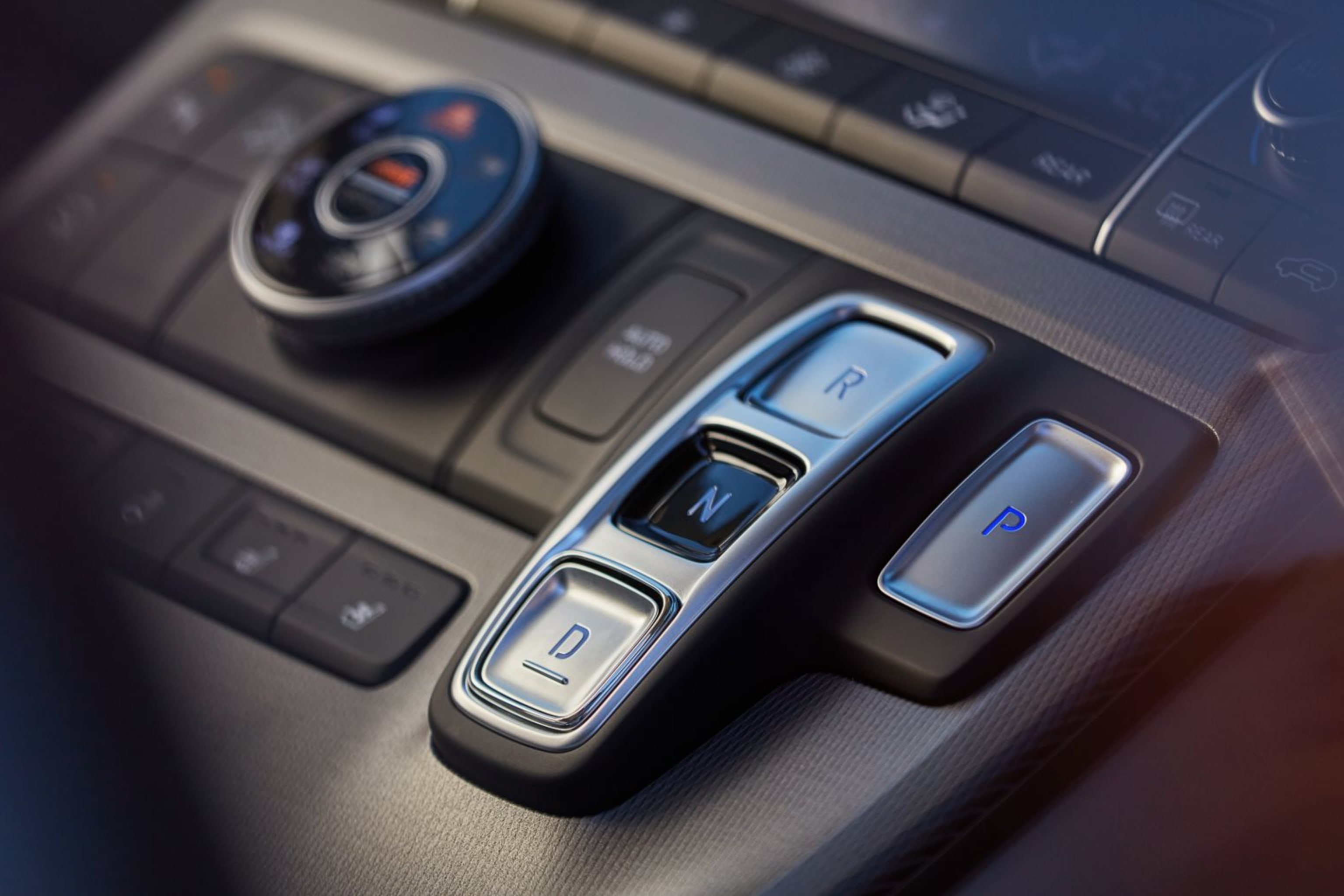
The eight-speed auto usually has no trouble finding the right gear when responding to pedal inputs, but there were occasions when using the active cruise control where it took time to settle whenever a speed change was required.
Otherwise, there isn’t much to complain about, though I can’t say I’m a fan of the push-button gear shifter, which is a little fiddly when parking.
In short, the Palisade offers a good mix of ride comfort and driver enjoyment with the diesel’s AWD traction, fuel economy and extra torque making it the superior of the two powertrains.
Safety

The Palisade is equipped with Hyundai’s SmartSense advanced driver assistance system that includes autonomous emergency braking with cyclist and pedestrian detection and will even brake if it detects another vehicle approaching from the side while you’re reversing.
It also has blind-spot monitoring, driver attention alert, lane following assist and lane departure warning, high-beam assist, rear occupant alert, and smart adaptive cruise control.
Rain-sensing windscreen wipers, which are more a convenience than a safety feature, are a notable omission for a vehicle at this price point.
Parking this five-metre behemoth is made easier with front and rear parking sensors with audio and radar-like visual display, and a reversing camera with guidelines and front and side view monitors.
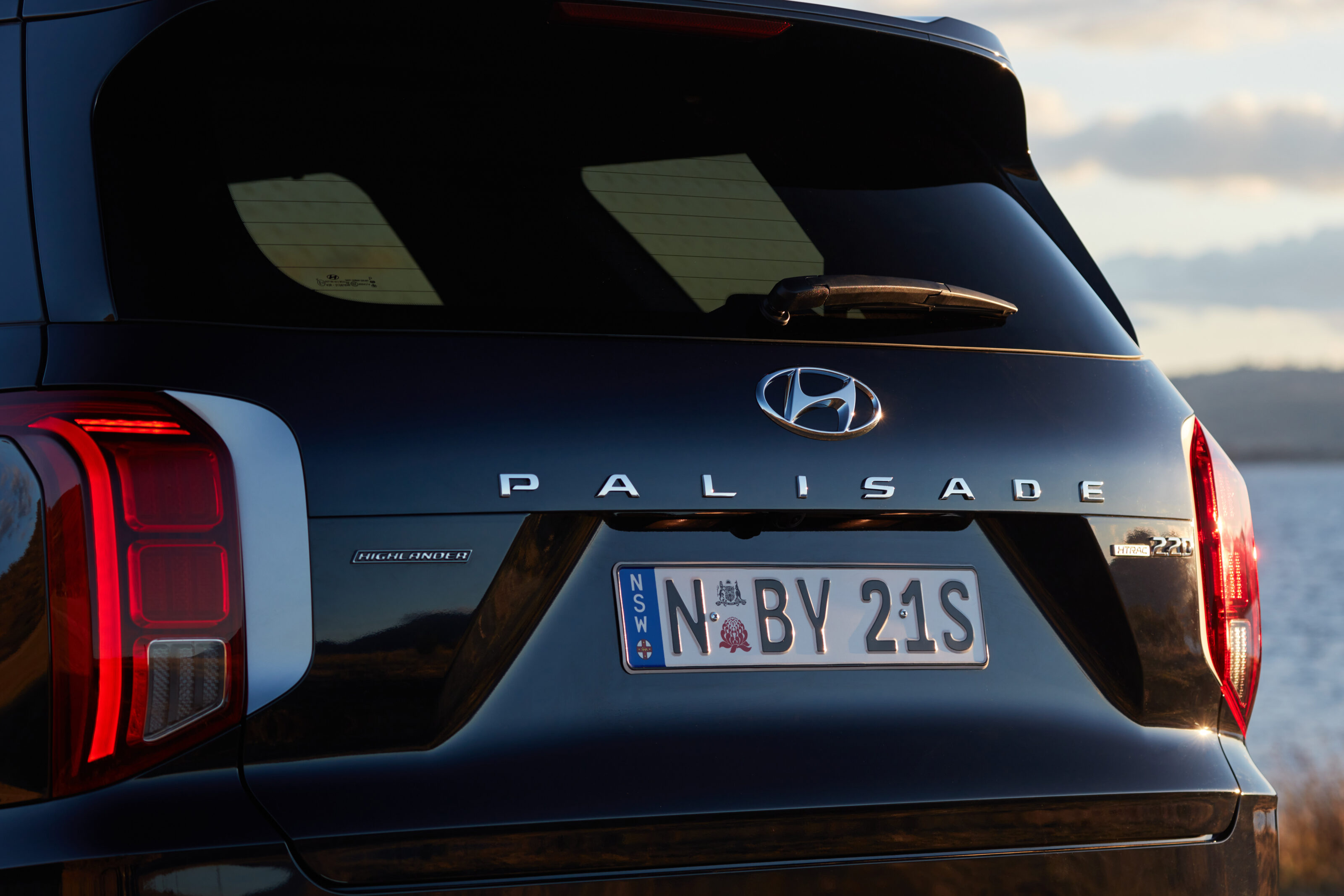
The Palisade has six airbags; driver and front passenger front and side; and curtain bags across all three rows.
There are also three sets of ISOFIX child seat anchor points (two in the second row and one in the third), three second-row top tethers, two third-row top tethers, child-proof rear door locks and a door-open warning.
At the time of writing, the Hyundai Palisade had yet to receive an ANCAP safety rating but it did receive a five-star crash test rating by the National Highway Traffic and Safety Administration (NHTSA), which is the US government’s version of the New Car Assessment Program (NCAP).
VERDICT
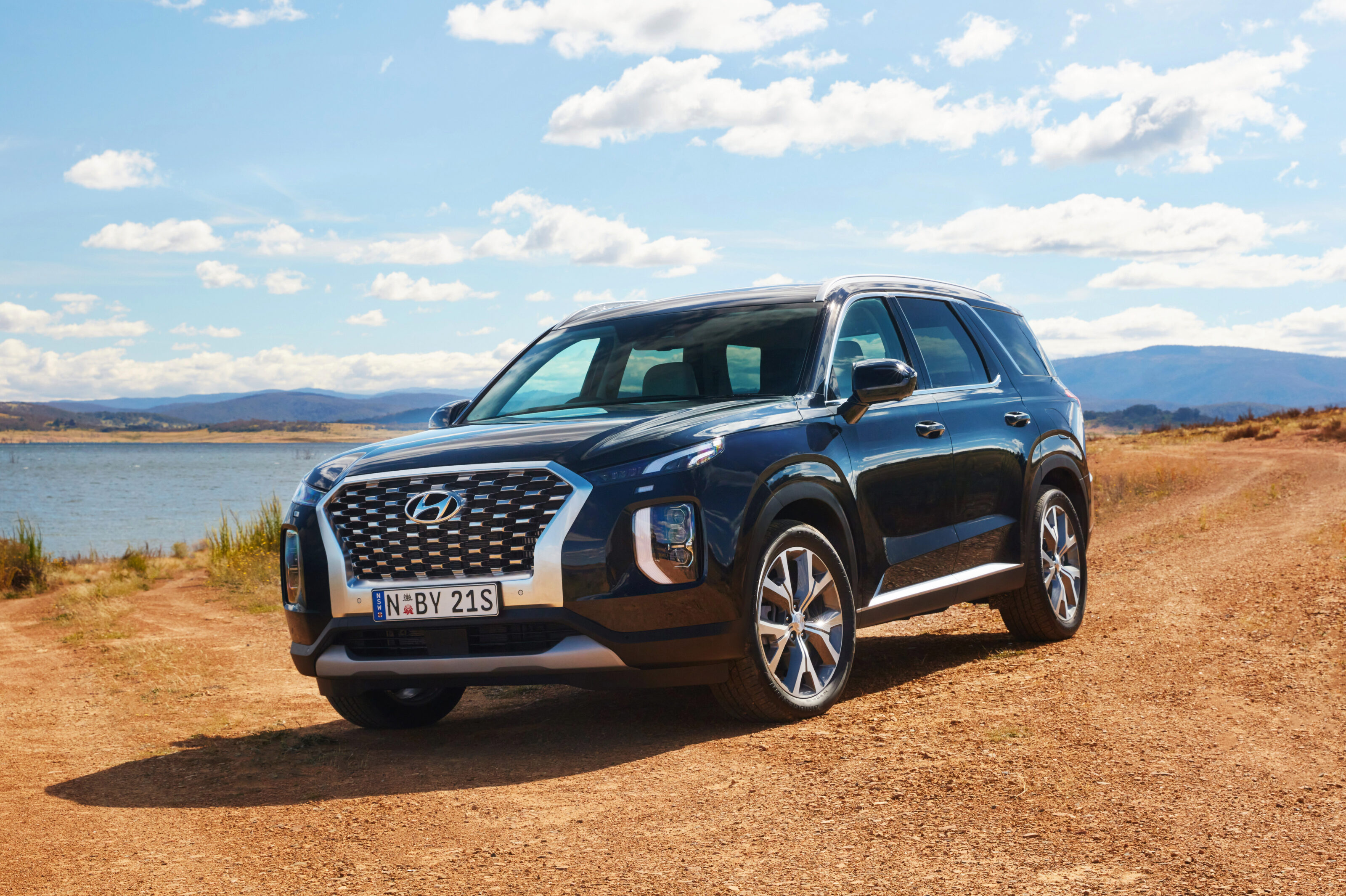
I remember driving the Kia Carnival and thinking it would be a great vehicle to own if I had a big family or needed something to regularly haul a few bodies around. But, while the Palisade is about the same size, it wouldn’t take such a caveat for me to purchase one.
Fact is, I like big SUVs and I cannot lie. Their huge footprint makes gives them wagon-like proportions and a stately feel and presence on the road. The Palisade is no different.
I’d happily have one as a two-row SUV with a big 704-litre boot space and spacious pop-up third row when needed.
And, while I like the captain’s chairs in the seven-seater, I reckon I’d choose the eight-seater just in case…
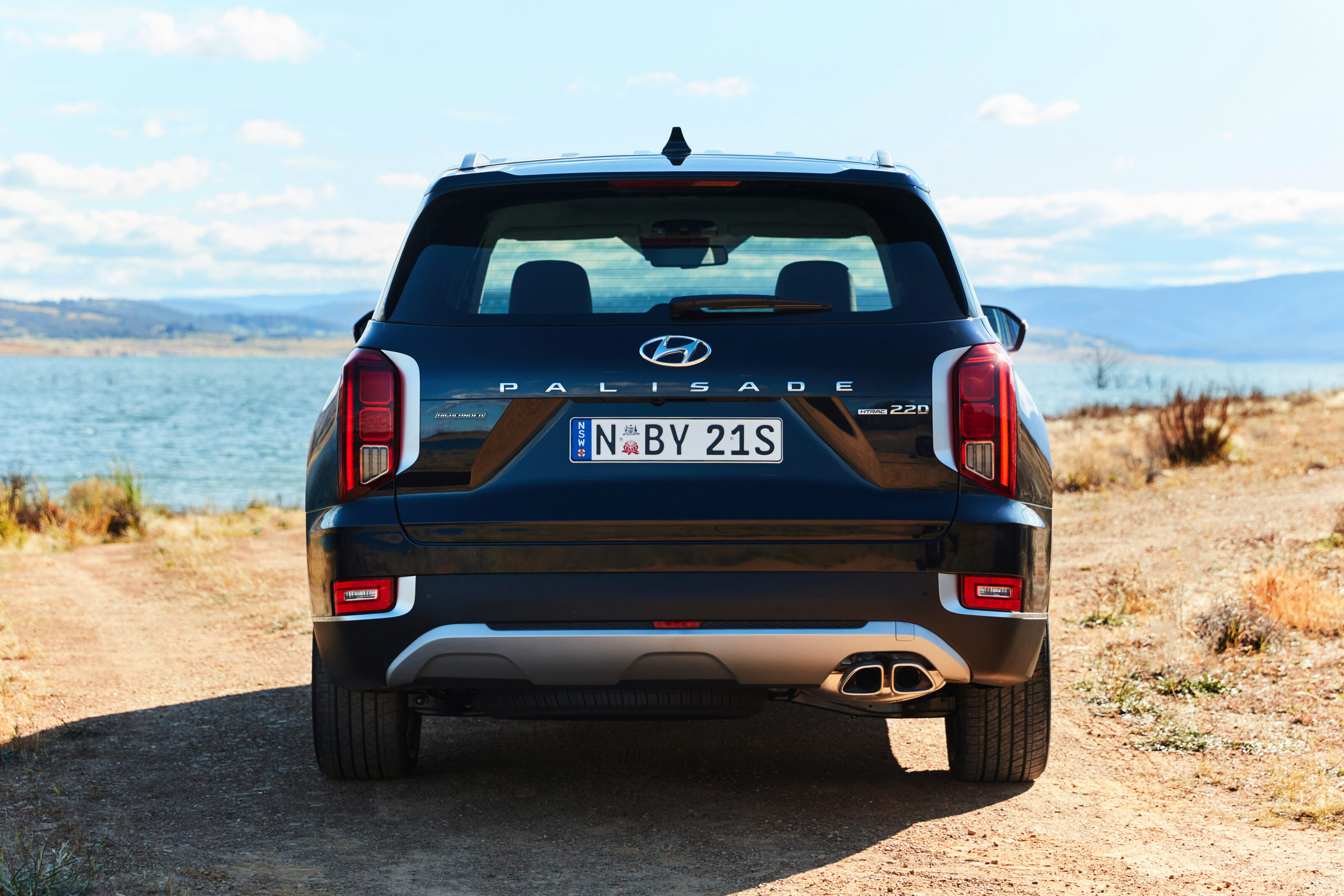
In what is a recurring theme whenever we review the bigger Hyundai and Kia SUVs, the diesel AWD is the pick of the Palisade powertrains and worth the additional $4000 due to its superior economy and refinement over the V6 petrol.
Spec wise, each variant represents good value when it comes to equipment levels, which makes it easy to declare this mid-spec Palisade Elite Diesel AWD the sweet spot of the range.
2022 Hyundai Palisade Elite 2.2L AWD specifications
| Body | 5-door large SUV |
|---|---|
| Drive | all-wheel drive |
| Engine | 2.2-litre four-cylinder turbo-diesel |
| Transmission | 8-speed auto |
| Power | 147kW @ 3800rpm |
| Torque | 240Nm @ 1750-2750rpm |
| Bore x stroke | 85.4mm x 96.0mm |
| Compression ratio | 16:1 |
| 0-100km/h | N/A |
| Fuel consumption | 7.3L/100km |
| Weight (7 seats) | 1983kg (tare mass) |
| Suspension | MacPherson strut (front); multi-link (rear) |
| L/W/H | 4980/1975/1750mm |
| Wheelbase | 2900mm |
| Brakes | 340 x 30mm/314 x 18mm ventilated front/rear discs, |
| Tyres | 245/50 R20 Bridgestone Dueler H/P Sport |
| Wheels | 20 x 7.5J + 49.5 alloys |
| Price | $65,500 plus on-road costs |
Score breakdown
Things we like
- Bold but handsome looks
- Space and comfort
- AWD diesel powertrain
- Three-row boot space
Not so much
- Push button gear-selector
- Transmission busy in active cruise control






